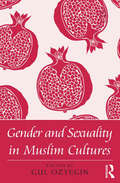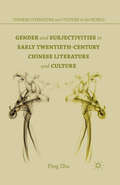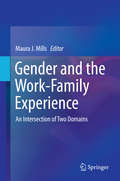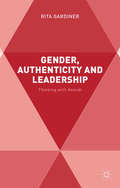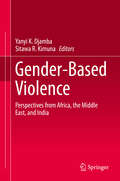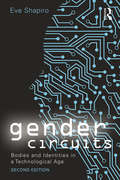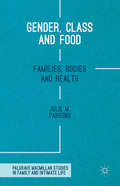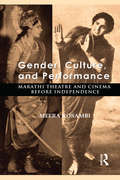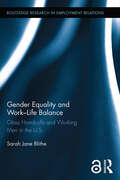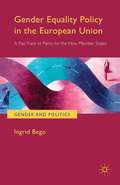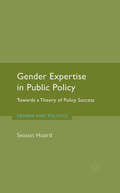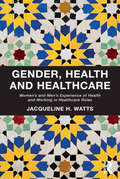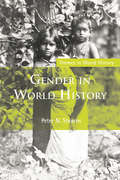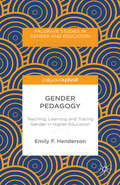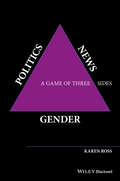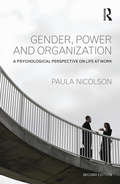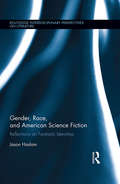- Table View
- List View
Gender and Sexuality in Muslim Cultures
by Gul OzyeginA must-read for anyone interested in Muslim cultures, this volume not only explores Muslim identities through the lens of sexuality and gender - their historical and contemporary transformations and local and global articulations - but also interrogates our understanding of what constitutes a ’Muslim’ identity in selected Muslim-majority countries at this pivotal historical moment, characterized by transformative destabilizations in which national, ethnic, and religious boundaries are being re-imagined and re-made. Contributors take on the most fundamental questions at the intersections of gender, sexuality, and the body. Several overarching questions frame the volume: How does studying gender and sexuality expand and enrich our understanding of Muslim-majority countries, historically and at present? How does the embodiment of ’Muslim’ identity get reconfigured in the context of twenty-first-century globalism? What analytical questions are raised about ’Islam’ when its diverse meanings and multifaceted expressions are closely examined? What roles do gender and sexuality play in the construction of cultural, religious, nationalistic, communal, and militaristic identities? How have power struggles been signified in and on the bodies of women and sexuality? How have global dynamics, such as the intensification and spread of neoliberal ideologies and policies, affected changing dynamics of gender and sexuality in specific locales? Here global dynamics touch down in diverse contexts, from masculinity crises around war disabilities, transnational marriages, and fathering in Turkey, Egypt, and Pakistan; to Muslim femininity narratives around female genital cutting, sexuality in divorce proceedings, and spouse selection; to gender crossing practices as well as protesting bodies, queering voices, and claims of authenticity in literary and political discourse. This book brings exciting research on these and other topics together in one place, allowing the essa
Gender and Subjectivities in Early Twentieth-Century Chinese Literature and Culture (Chinese Literature and Culture in the World)
by P. ZhuThrough both cultural and literary analysis, this book examines gender in relation to late Qing and modern Chinese intellectuals, including Mu Shiying, Bai Wei, and Lu Xun. Tackling important, previously neglected questions, Zhu ultimately shows the resilience and malleability of Chinese modernity through its progressive views on femininity.
Gender and the Work-Family Experience: An Intersection of Two Domains
by Maura J. MillsConflict between work and family has been a topic of discussion since the beginning of the women's movement, but recent changes in family structures and workforce demographics have made it clear that the issues impact both women and men. While employers and policymakers struggle to navigate this new terrain, critics charge that the research sector, too, has been slow to respond.Gender and the Work-Family Experience puts multiple faces – male as well as female – on complex realities with interdisciplinary and cross-cultural awareness and research-based insight. Besides reviewing the state of gender roles as they affect home and career, this in-depth reference examines and compares how women and men experience work-family conflict and its consequences for relationships at home as well as outcomes on the job. Topics as wide-ranging as gendered occupations, gender and shiftwork, heteronormative assumptions, the myth of the ideal worker, and gendered aspects of work-family guilt reflect significant changes in society and reveal important implications for both research and policy. Also included in the coverage: Gender ideology and work-family plans of the next generationGender, poverty, and the work-family interfaceThe double jeopardy effect: the importance of gender and race in work-family researchWhen work intrudes upon employees’ personal time: does gender matter?Work-family equality: the importance of a level playing field at homeWomen in STEM: family-related challenges and initiativesFamily-friendly organizational policies, practices, and benefits through the gender lensGeared toward work-family and gender researchers as well as students and educators in a variety of fields, Gender and the Work-Family Experience will find interested readers in the fields of industrial and organizational psychology, business management, social psychology, sociology, gender studies, women’s studies, and public policy, among others..
Gender, Authenticity and Leadership: Thinking with Arendt
by R. GardinerThis book examines the conceptual underpinnings of authentic leadership to discover why so little attention has been paid to gender. The author explores the failure to interrogate the complexities surrounding the concept of authenticity, especially as it relates to the diversity of lived experience.
Gender-Based Violence: Perspectives from Africa, the Middle East, and India
by Yanyi K. Djamba Sitawa R. KimunaThis book offers new perspectives on gender-based violence in three regions where the subject has been taboo in everyday discourse often due to patriarchal cultural norms that limit women’s autonomy. The contributions to this book provide rare insight into not only the levels and the socio-demographic determinants of domestic violence, but topics ranging from men’s attitudes toward wife beating; domestic violence-related adolescent deaths, and women’s health problems due to sexual and physical abuse. With a comprehensive introduction that provides a comparative international research framework for discussing gender-based violence in these three unique regions, this volume provides a key basis for understanding gender-based violence on a more global level.Part I, on Africa, covers men’s attitudes towards domestic violence, the impact of poverty and fertility, the association between adolescent deaths and domestic violence, and the link between domestic abuse and HIV.Part II, on the Middle East, covers the importance of consanguinity on domestic violence in Egypt and Jordan, the effects of physical abuse on reproductive health, and the link between political unrests and women’s experience and attitudes towards domestic violence.Part III, on India, shows how sexual abuse puts women at risk of reproductive tract infections and sexually transmitted infections, as well as the role of gender norms in wife abuse and the role of youth aggressive behavior in nonconsensual sex.With such a deep and broad coverage of factors of intimate partner abuse, this book serves as a reference document for researchers, decision-makers, and organizations that are searching for ways to reduce gender-based domestic violence. This book is of interest for researchers in Criminology and Criminal Justice, as well as Sociology, Social Work, Public Health and Human Rights.
Gender Circuits: Bodies and Identities in a Technological Age (Sociology Re-Wired)
by Eve ShapiroThe new edition of Gender Circuits explores the impact of new technologies on the gendered lives of individuals through substantive sociological analysis and in-depth case studies. Examining the complex intersections between gender ideologies, social scripts, information and biomedical technologies, and embodied identities, this book explores whether and how new technologies are reshaping what it means to be a gendered person in contemporary society.
Gender Circuits: Bodies and Identities in a Technological Age (Sociology Re-Wired)
by Eve ShapiroThe new edition of Gender Circuits explores the impact of new technologies on the gendered lives of individuals through substantive sociological analysis and in-depth case studies. Examining the complex intersections between gender ideologies, social scripts, information and biomedical technologies, and embodied identities, this book explores whether and how new technologies are reshaping what it means to be a gendered person in contemporary society.
Gender, Class and Food: Families, Bodies and Health (Palgrave Macmillan Studies in Family and Intimate Life)
by Julie M. ParsonsEveryday foodways are a powerful means of drawing boundaries between social groups and defining who we are and where we belong. This book draws upon auto/biographical food narratives and emphasises the power of everyday foodways in maintaining and reinforcing social divisions along the lines of gender and class.
Gender, Culture, and Performance: Marathi Theatre and Cinema before Independence
by Meera KosambiThis book presents a lucid, comprehensive, and entertaining narrative of culture and society in late 19th- and early 20th-century Maharashtra through a perceptive study of its theatre and cinema. An intellectual tour de force, it will be invaluable to scholars and researchers of modern Indian history, theatre and film studies, cultural studies, sociology, gender studies as well as the interested general reader.
Gender, Culture, and Performance: Marathi Theatre and Cinema before Independence
by Meera KosambiThis book presents a lucid, comprehensive, and entertaining narrative of culture and society in late 19th- and early 20th-century Maharashtra through a perceptive study of its theatre and cinema. An intellectual tour de force, it will be invaluable to scholars and researchers of modern Indian history, theatre and film studies, cultural studies, sociology, gender studies as well as the interested general reader.
Gender Equality and Work-Life Balance: Glass Handcuffs and Working Men in the U.S. (Routledge Research in Employment Relations)
by Sarah BlithePressure to achieve work-life "balance" has recently become a significant part of the cultural fabric of working life in United States. A very few privileged employees tout their ability to find balance between their careers and the rest of their lives, but most employees face considerable organizational and economic constraints which hamper their ability to maintain a reasonable "balance" between paid work and other life aspects—and it is not only women who struggle. Increasingly men find it difficult to "do it all." Women have long noted the near impossibility of balancing multiple roles, but it is only recently that men have been encouraged to see themselves beyond their breadwinner selves. Gender Equality and Work-Life Balance describes the work-life practices of men in the United States. The purpose is to increase gender equality at work for all employees. With a focus on leave policy inequalities, this book argues that men experience a phenomenon called "the glass handcuffs," which prevents them from leaving work to participate fully in their families, homes, and other life events, highlighting the cultural, institutional, organizational, and occupational conditions which make gender equality in work-life policy usage difficult. This social justice book ultimately draws conclusions about how to minimize inequalities at work. Gender Equality and Work-Life Balance is unique as it laces together some theoretical concepts which have little previous association, including entrepreneurialism; leave policy, occupational identity, and the economic necessities of families. This book will therefore be of particular interest to researches and academics alike in the disciplines of Gender studies, Human Resource Management, Employment Relations, Sociology and Cultural Studies.
Gender Equality and Work-Life Balance: Glass Handcuffs and Working Men in the U.S. (Routledge Research in Employment Relations)
by Sarah BlithePressure to achieve work-life "balance" has recently become a significant part of the cultural fabric of working life in United States. A very few privileged employees tout their ability to find balance between their careers and the rest of their lives, but most employees face considerable organizational and economic constraints which hamper their ability to maintain a reasonable "balance" between paid work and other life aspects—and it is not only women who struggle. Increasingly men find it difficult to "do it all." Women have long noted the near impossibility of balancing multiple roles, but it is only recently that men have been encouraged to see themselves beyond their breadwinner selves. Gender Equality and Work-Life Balance describes the work-life practices of men in the United States. The purpose is to increase gender equality at work for all employees. With a focus on leave policy inequalities, this book argues that men experience a phenomenon called "the glass handcuffs," which prevents them from leaving work to participate fully in their families, homes, and other life events, highlighting the cultural, institutional, organizational, and occupational conditions which make gender equality in work-life policy usage difficult. This social justice book ultimately draws conclusions about how to minimize inequalities at work. Gender Equality and Work-Life Balance is unique as it laces together some theoretical concepts which have little previous association, including entrepreneurialism; leave policy, occupational identity, and the economic necessities of families. This book will therefore be of particular interest to researches and academics alike in the disciplines of Gender studies, Human Resource Management, Employment Relations, Sociology and Cultural Studies.
Gender Equality Policy in the European Union: A Fast Track to Parity for the New Member States (Gender and Politics)
by Ingrid BegoOne of the solutions proposed by the European Union to remedy the effects of the 2008 economic crisis is to increase female labour participation. This book explores the policy changes in four new member states that may reduce the gender employment gap and improve women's equal participation in the labour force.
Gender Expertise in Public Policy: Towards a Theory of Policy Success (Gender and Politics)
by S. HoardThrough a selection of in-depth interviews, a survey of experts working with the European Union and United Nations, and Qualitative Comparative Analysis of policy debates, this text rethinks our understanding of gender expertise and the circumstances that lead to expert success in public policy.
Gender, Health and Healthcare: Women’s and Men’s Experience of Health and Working in Healthcare Roles
by Jacqueline H. WattsHealth status and the experience of working in health care roles are both strongly shaped by gender and, although there have been attempts to incorporate ’gender awareness’ in both health and employment policies, the significance of gender in these areas continues to be marginalised within public debates and academic discourses. Taking a social constructionist perspective, Watts considers the ways in which gender impacts upon health in all its elements including access, technology, professionalisation, health promotion and health as an important sector of the labour market. She discusses gender as a developing and diversified category, exploring ideas about masculinity and the fluidity of gender boundaries in determining individual identity. Chapters that follow discuss men’s and women’s health; ideology of gender and health, specifically exploring different social norms and ideas about male and female health and the dominant ideological association between femaleness and caring; working for health with particular focus on the gendered interplay of caring and curing roles; technology and changes to gender, health and healthcare; health promotion as a gendered activity and, finally, the importance of introducing an intersectional approach beyond gender to articulate a deeper understanding of health in a postmodern context. The concluding chapter draws together these themes to underscore the importance of placing gender at the centre of health and health care delivery to fully take account of both the different life and health experiences of men and women and the gendered dimensions of working in health care.
Gender, Health and Healthcare: Women’s and Men’s Experience of Health and Working in Healthcare Roles
by Jacqueline H. WattsHealth status and the experience of working in health care roles are both strongly shaped by gender and, although there have been attempts to incorporate ’gender awareness’ in both health and employment policies, the significance of gender in these areas continues to be marginalised within public debates and academic discourses. Taking a social constructionist perspective, Watts considers the ways in which gender impacts upon health in all its elements including access, technology, professionalisation, health promotion and health as an important sector of the labour market. She discusses gender as a developing and diversified category, exploring ideas about masculinity and the fluidity of gender boundaries in determining individual identity. Chapters that follow discuss men’s and women’s health; ideology of gender and health, specifically exploring different social norms and ideas about male and female health and the dominant ideological association between femaleness and caring; working for health with particular focus on the gendered interplay of caring and curing roles; technology and changes to gender, health and healthcare; health promotion as a gendered activity and, finally, the importance of introducing an intersectional approach beyond gender to articulate a deeper understanding of health in a postmodern context. The concluding chapter draws together these themes to underscore the importance of placing gender at the centre of health and health care delivery to fully take account of both the different life and health experiences of men and women and the gendered dimensions of working in health care.
Gender in World History (Themes in World History)
by Peter N. StearnsCovering societies from classical times to the twenty-first century, Gender in World History is a fascinating exploration of what happens to established ideas about men, women, and gender roles when different cultural systems come into contact. The book breaks new ground to facilitate a consistent approach to gender in a world history context. Now in its third edition, the book has been thoroughly updated, including: expanded treatment of Africa under Islamic influence expanded discussion of southeast Asia a new chapter on contemporary Latin America representations of individual women engagement with recent work on gender history and theory. With truly global coverage, this book enables students to understand how gender roles have varied across the world and over time, and the vital role of gender in structuring social and political relationships. Providing a succinct, current overview of the history of gender throughout the world, Gender in World History remains essential reading for students of world history.
Gender in World History (Themes in World History)
by Peter N. StearnsCovering societies from classical times to the twenty-first century, Gender in World History is a fascinating exploration of what happens to established ideas about men, women, and gender roles when different cultural systems come into contact. The book breaks new ground to facilitate a consistent approach to gender in a world history context. Now in its third edition, the book has been thoroughly updated, including: expanded treatment of Africa under Islamic influence expanded discussion of southeast Asia a new chapter on contemporary Latin America representations of individual women engagement with recent work on gender history and theory. With truly global coverage, this book enables students to understand how gender roles have varied across the world and over time, and the vital role of gender in structuring social and political relationships. Providing a succinct, current overview of the history of gender throughout the world, Gender in World History remains essential reading for students of world history.
Gender Pedagogy: Teaching, Learning and Tracing Gender in Higher Education (Palgrave Studies in Gender and Education)
by E. HendersonWhen addressed in its full reactive potential, gender has a tendency to unfix the reassuring certainties of education and academia. Gender pedagogy unfolds as an account of teaching gender learning that is rooted in Derrida's concept of the 'trace', reflecting the unfixing properties of gender and even shaking up academic knowledge production.
Gender, Politics, News: A Game of Three Sides
by Karen RossGender, Politics, News: A Game of Three Sides explores the role of gender in the broader processes of political communication The only contemporary book focusing on the relationships between gender, politics, and news media which takes a global perspective An analysis of political journalism as a practice and the development of the field in terms of gendered workplace cultures Offers a solid framework for understanding women’s political representation, including real world case studies of women’s campaigns for the top political job across a range of different geographies and contexts Coverage of hot-button issues, such as political scandal and the role of new and social media in politics and elections, makes this a highly relevant and current work with resonances for a wide audience
Gender, Politics, News: A Game of Three Sides
by Karen RossGender, Politics, News: A Game of Three Sides explores the role of gender in the broader processes of political communication The only contemporary book focusing on the relationships between gender, politics, and news media which takes a global perspective An analysis of political journalism as a practice and the development of the field in terms of gendered workplace cultures Offers a solid framework for understanding women’s political representation, including real world case studies of women’s campaigns for the top political job across a range of different geographies and contexts Coverage of hot-button issues, such as political scandal and the role of new and social media in politics and elections, makes this a highly relevant and current work with resonances for a wide audience
Gender, Power and Organization: A psychological perspective on life at work
by Paula NicolsonWork organizations are a major site of gender politics for professional women and men, and although there are more women in senior positions than ever before, these increased opportunities have not been gained without psychological consequences. Evidence-based and theoretically driven, the new edition of Gender, Power and Organization raises important questions about gender and power in the workplace, and the psychology of women’s advancement. Twenty years on from the first edition, it re-examines gender relations at work and asks why, despite many years of feminist critique and action, we are able to understand the dynamics of the workplace but fail to make them more representative. The struggles women face in professional and public life remain intense, not least because many men experience an increasing sense of threat to their long-term aspirations and professional positions. Using examples from recent research and the author's own consultancy experience, this important volume offers a fresh exploration of the psychology of gender and power at work, from the development of gender identities and roles, to explanations of bullying and sexual harassment in the organization. It offers an accessible survey of the subject for professional managers and students of leadership, psychology, management, sociology, gender, and women’s studies.
Gender, Power and Organization: A psychological perspective on life at work
by Paula NicolsonWork organizations are a major site of gender politics for professional women and men, and although there are more women in senior positions than ever before, these increased opportunities have not been gained without psychological consequences. Evidence-based and theoretically driven, the new edition of Gender, Power and Organization raises important questions about gender and power in the workplace, and the psychology of women’s advancement. Twenty years on from the first edition, it re-examines gender relations at work and asks why, despite many years of feminist critique and action, we are able to understand the dynamics of the workplace but fail to make them more representative. The struggles women face in professional and public life remain intense, not least because many men experience an increasing sense of threat to their long-term aspirations and professional positions. Using examples from recent research and the author's own consultancy experience, this important volume offers a fresh exploration of the psychology of gender and power at work, from the development of gender identities and roles, to explanations of bullying and sexual harassment in the organization. It offers an accessible survey of the subject for professional managers and students of leadership, psychology, management, sociology, gender, and women’s studies.
Gender, Race, and American Science Fiction: Reflections on Fantastic Identities (Routledge Interdisciplinary Perspectives on Literature)
by Jason HaslamThis book focuses on the interplay of gender, race, and their representation in American science fiction, from the nineteenth-century through to the twenty-first, and across a number of forms including literature and film. Haslam explores the reasons why SF provides such a rich medium for both the preservation of and challenges to dominant mythologies of gender and race. Defining SF linguistically and culturally, the study argues that this mode is not only able to illuminate the cultural and social histories of gender and race, but so too can it intervene in those histories, and highlight the ruptures present within them. The volume moves between material history and the linguistic nature of SF fantasies, from the specifics of race and gender at different points in American history to larger analyses of the socio-cultural functions of such identity categories. SF has already become central to discussions of humanity in the global capitalist age, and is increasingly the focus of feminist and critical race studies; in combining these earlier approaches, this book goes further, to demonstrate why SF must become central to our discussions of identity writ large, of the possibilities and failings of the human —past, present, and future. Focusing on the interplay of whiteness and its various 'others' in relation to competing gender constructs, chapters analyze works by Nathaniel Hawthorne, Mary E. Bradley Lane, Edgar Rice Burroughs, Philip Francis Nowlan, George S. Schuyler and the Wachowskis, Frank Herbert, William Gibson, and Octavia Butler. Academics and students interested in the study of Science Fiction, American literature and culture, and Whiteness Studies, as well as those engaged in critical gender and race studies, will find this volume invaluable.
Gender, Race, and American Science Fiction: Reflections on Fantastic Identities (Routledge Interdisciplinary Perspectives on Literature)
by Jason HaslamThis book focuses on the interplay of gender, race, and their representation in American science fiction, from the nineteenth-century through to the twenty-first, and across a number of forms including literature and film. Haslam explores the reasons why SF provides such a rich medium for both the preservation of and challenges to dominant mythologies of gender and race. Defining SF linguistically and culturally, the study argues that this mode is not only able to illuminate the cultural and social histories of gender and race, but so too can it intervene in those histories, and highlight the ruptures present within them. The volume moves between material history and the linguistic nature of SF fantasies, from the specifics of race and gender at different points in American history to larger analyses of the socio-cultural functions of such identity categories. SF has already become central to discussions of humanity in the global capitalist age, and is increasingly the focus of feminist and critical race studies; in combining these earlier approaches, this book goes further, to demonstrate why SF must become central to our discussions of identity writ large, of the possibilities and failings of the human —past, present, and future. Focusing on the interplay of whiteness and its various 'others' in relation to competing gender constructs, chapters analyze works by Nathaniel Hawthorne, Mary E. Bradley Lane, Edgar Rice Burroughs, Philip Francis Nowlan, George S. Schuyler and the Wachowskis, Frank Herbert, William Gibson, and Octavia Butler. Academics and students interested in the study of Science Fiction, American literature and culture, and Whiteness Studies, as well as those engaged in critical gender and race studies, will find this volume invaluable.
